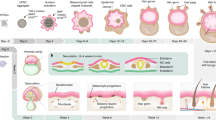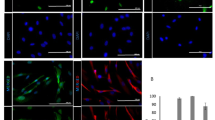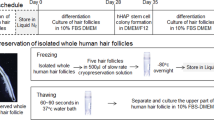Abstract
The ease of generating induced pluripotent stem (iPS) cells, and possibly their properties after reprogramming, depends on the origin of the somatic cell starting population. Reprogramming of keratinocytes is both faster and more efficient compared with fibroblasts, although more care is required when isolating, culturing and infecting these cells. In this study, we describe detailed protocols using both feeder-dependent and defined serum- and feeder-free conditions for culturing human keratinocytes from foreskin samples and punch biopsies, as well as how to isolate keratinocytes from plucked hair. We further describe culture techniques and approaches to efficiently infect and reprogram these cells for the purpose of generating iPS cells. The procedure of deriving keratinocytes takes 10–14 d, whereas reprogramming and the appearance of iPS cell colonies that can be isolated and established requires another 3–4 weeks.
This is a preview of subscription content, access via your institution
Access options
Subscribe to this journal
Receive 12 print issues and online access
$259.00 per year
only $21.58 per issue
Buy this article
- Purchase on Springer Link
- Instant access to full article PDF
Prices may be subject to local taxes which are calculated during checkout





Similar content being viewed by others
References
Fuchs, E. Scratching the surface of skin development. Nature 445, 834–842 (2007).
Amoh, Y. et al. Human and mouse hair follicles contain both multipotent and monopotent stem cells. Cell Cycle 8, 176–177 (2009).
Ito, M. et al. Stem cells in the hair follicle bulge contribute to wound repair but not to homeostasis of the epidermis. Nat. Med. 11, 1351–1354 (2005).
Rheinwald, J.G. & Green, H. Serial cultivation of strains of human epidermal keratinocytes: the formation of keratinizing colonies from single cells. Cell 6, 331–343 (1975).
Tenchini, M.L., Ranzati, C. & Malcovati, M. Culture techniques for human keratinocytes. Burns 18 (Suppl 1): S11–S16 (1992).
Detmar, M., Schaart, F.M., Blume, U. & Orfanos, C.E. Culture of hair matrix and follicular keratinocytes. J. Invest. Dermatol. 101, 130S–134S (1993).
Wells, J. A simple technique for establishing cultures of epithelial cells. Br. J. Dermatol. 107, 481–482 (1982).
Moll, I. Differential epithelial outgrowth of plucked and microdissected human hair follicles in explant culture. Arch. Dermatol. Res. 288, 604–610 (1996).
Limat, A. & Noser, F.K. Serial cultivation of single keratinocytes from the outer root sheath of human scalp hair follicles. J. Invest. Dermatol. 87, 485–488 (1986).
Amoh, Y., Li, L., Katsuoka, K. & Hoffman, R.M. Multipotent nestin-expressing hair follicle stem cells. J. Dermatol. 36, 1–9 (2009).
Hunt, D.P. et al. A highly enriched niche of precursor cells with neuronal and glial potential within the hair follicle dermal papilla of adult skin. Stem Cells 26, 163–172 (2008).
Yu, H. et al. Isolation of a novel population of multipotent adult stem cells from human hair follicles. Am. J. Pathol. 168, 1879–1888 (2006).
Amoh, Y., Li, L., Katsuoka, K., Penman, S. & Hoffman, R.M. Multipotent nestin-positive, keratin-negative hair-follicle bulge stem cells can form neurons. Proc. Natl. Acad. Sci. USA 102, 5530–5534 (2005).
Takahashi, K. et al. Induction of pluripotent stem cells from adult human fibroblasts by defined factors. Cell 131, 861–872 (2007).
Yamanaka, S. Elite and stochastic models for induced pluripotent stem cell generation. Nature 460, 49–52 (2009).
Muller, L.U., Daley, G.Q. & Williams, D.A. Upping the ante: recent advances in direct reprogramming. Mol. Ther. 17, 947–953 (2009).
Aasen, T. et al. Efficient and rapid generation of induced pluripotent stem cells from human keratinocytes. Nat. Biotechnol. 26, 1276–1284 (2008).
Raya, A. et al. Disease-corrected haematopoietic progenitors from Fanconi anaemia induced pluripotent stem cells. Nature 460, 53–59 (2009).
Utikal, J., Maherali, N., Kulalert, W. & Hochedlinger, K. Sox2 is dispensable for the reprogramming of melanocytes and melanoma cells into induced pluripotent stem cells. J. Cell Sci. 122, 3502–3510 (2009).
Lerou, P.H. et al. Derivation and maintenance of human embryonic stem cells from poor-quality in vitro fertilization embryos. Nat. Protoc. 3, 923–933 (2008).
Gilfix, B.M. & Green, H. Bioassay of retinoids using cultured human conjunctival keratinocytes. J. Cell Physiol. 119, 172–174 (1984).
Park, I.H., Lerou, P.H., Zhao, R., Huo, H. & Daley, G.Q. Generation of human-induced pluripotent stem cells. Nat. Protoc. 3, 1180–1186 (2008).
Acknowledgements
We are grateful to Dr. Agustín Toll Abelló at the Hospital del Mar (Barcelona, Spain) for facilitating collection of skin samples. We thank Marta Berini Pérez for drawing Figure 1. This study was supported by grants from Fundacion Cellex, the G. Harold and Leila Y. Mathers Charitable Foundation, Marato de TV3, CIBER and MICINN.
Author information
Authors and Affiliations
Contributions
T.A. designed the protocol and all experimental procedures, wrote the paper and prepared figures. J.C.I.B. is a project lead and assisted with the preparation of the paper.
Corresponding author
Rights and permissions
About this article
Cite this article
Aasen, T., Belmonte, J. Isolation and cultivation of human keratinocytes from skin or plucked hair for the generation of induced pluripotent stem cells. Nat Protoc 5, 371–382 (2010). https://doi.org/10.1038/nprot.2009.241
Published:
Issue Date:
DOI: https://doi.org/10.1038/nprot.2009.241
This article is cited by
-
Induced pluripotent stem cells: ex vivo models for human diseases due to mitochondrial DNA mutations
Journal of Biomedical Science (2023)
-
Regulation of dermal fibroblasts by human neutrophil peptides
Scientific Reports (2023)
-
Nucleoporin downregulation modulates progenitor differentiation independent of nuclear pore numbers
Communications Biology (2023)
-
A multifunctional Wnt regulator underlies the evolution of rodent stripe patterns
Nature Ecology & Evolution (2023)
-
SerpinB7 deficiency contributes to development of psoriasis via calcium-mediated keratinocyte differentiation dysfunction
Cell Death & Disease (2022)
Comments
By submitting a comment you agree to abide by our Terms and Community Guidelines. If you find something abusive or that does not comply with our terms or guidelines please flag it as inappropriate.



